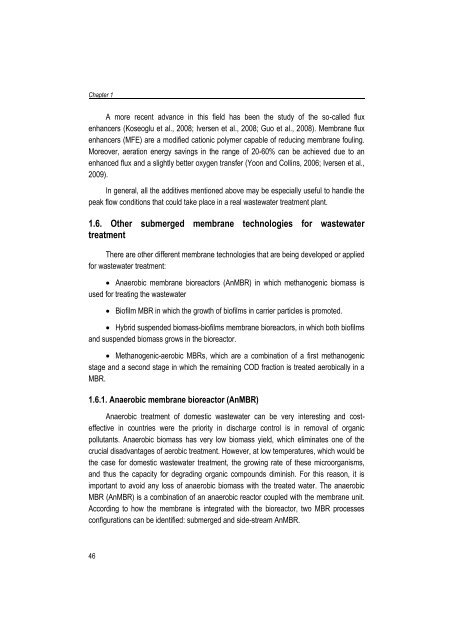Combining submerged membrane technology with anaerobic and ...
Combining submerged membrane technology with anaerobic and ...
Combining submerged membrane technology with anaerobic and ...
Create successful ePaper yourself
Turn your PDF publications into a flip-book with our unique Google optimized e-Paper software.
Chapter 1A more recent advance in this field has been the study of the so-called fluxenhancers (Koseoglu et al., 2008; Iversen et al., 2008; Guo et al., 2008). Membrane fluxenhancers (MFE) are a modified cationic polymer capable of reducing <strong>membrane</strong> fouling.Moreover, aeration energy savings in the range of 20-60% can be achieved due to anenhanced flux <strong>and</strong> a slightly better oxygen transfer (Yoon <strong>and</strong> Collins, 2006; Iversen et al.,2009).In general, all the additives mentioned above may be especially useful to h<strong>and</strong>le thepeak flow conditions that could take place in a real wastewater treatment plant.1.6. Other <strong>submerged</strong> <strong>membrane</strong> technologies for wastewatertreatmentThere are other different <strong>membrane</strong> technologies that are being developed or appliedfor wastewater treatment: Anaerobic <strong>membrane</strong> bioreactors (AnMBR) in which methanogenic biomass isused for treating the wastewater Biofilm MBR in which the growth of biofilms in carrier particles is promoted. Hybrid suspended biomass-biofilms <strong>membrane</strong> bioreactors, in which both biofilms<strong>and</strong> suspended biomass grows in the bioreactor. Methanogenic-aerobic MBRs, which are a combination of a first methanogenicstage <strong>and</strong> a second stage in which the remaining COD fraction is treated aerobically in aMBR.1.6.1. Anaerobic <strong>membrane</strong> bioreactor (AnMBR)Anaerobic treatment of domestic wastewater can be very interesting <strong>and</strong> costeffectivein countries were the priority in discharge control is in removal of organicpollutants. Anaerobic biomass has very low biomass yield, which eliminates one of thecrucial disadvantages of aerobic treatment. However, at low temperatures, which would bethe case for domestic wastewater treatment, the growing rate of these microorganisms,<strong>and</strong> thus the capacity for degrading organic compounds diminish. For this reason, it isimportant to avoid any loss of <strong>anaerobic</strong> biomass <strong>with</strong> the treated water. The <strong>anaerobic</strong>MBR (AnMBR) is a combination of an <strong>anaerobic</strong> reactor coupled <strong>with</strong> the <strong>membrane</strong> unit.According to how the <strong>membrane</strong> is integrated <strong>with</strong> the bioreactor, two MBR processesconfigurations can be identified: <strong>submerged</strong> <strong>and</strong> side-stream AnMBR.46
















